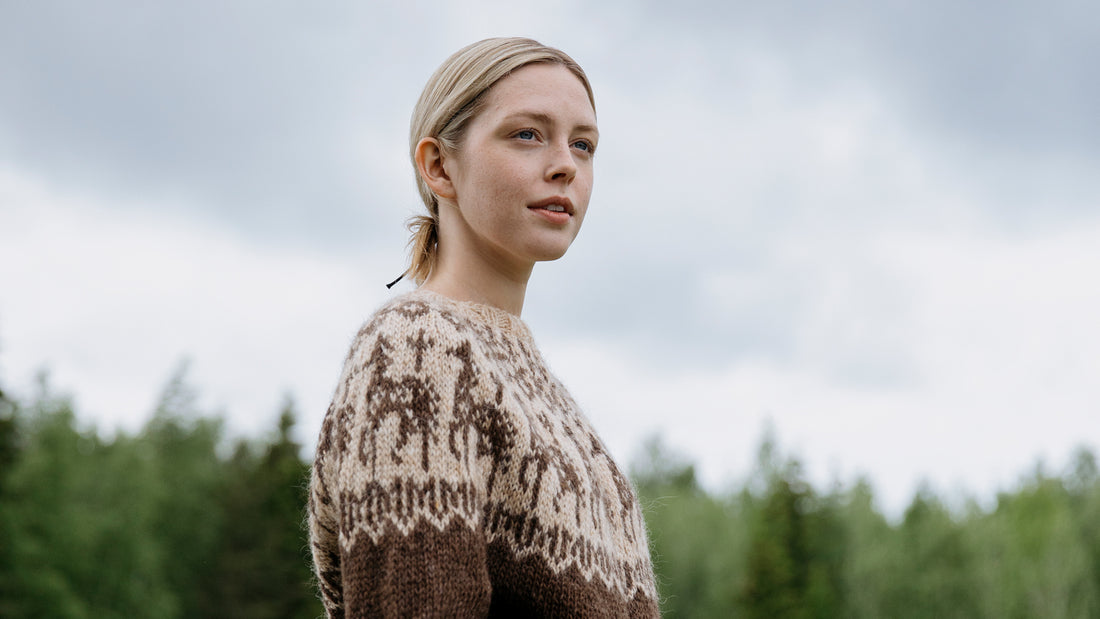What is Kalevala?
Author and knitwear designer Jenna Kostet looks into the history of Kalevala, the book that inspired the knitting patterns in her upcoming book.
Quite often I get questions about Kalevala from people outside of Finland. They are curious to know more about the work of literature that has inspired my knits. Their questions are always welcome, but the answers are not always straigh-forward, which is why I would like to talk more about the poem collection that inspired my book, Neulottu Kalevala.

Kalevala is considered a national epic of Finland. It’s a poem collection compiled by Elias Lönnrot (1802–1884), a Finnish physician, linguist and botanist who became interested in Finnish poetry when he was a student. Originally from poor conditions, Lönnrot had to finance his studies in many ways, either going from house to house and performing songs or working as a tailor like his father. During his studies, he became interested in folk poetry and in 1828 he made his first journey to collect poems through Central and Eastern Finland, from Häme and Savo all the way up to North Karelia. Throughout the years he traveled around Finland as well as to Estonia, Kola Peninsula, to the Arctic Circle and Karelia collecting material.

Whereas most of Finnish territory had previously been under Swedish rule, in 1809 Finland and Karelia became part of the Russian Empire as an autonomous Grand Duchy of Finland. In the decades leading up to the independence of Finland in 1917, a strong nationalistic movement had developed, calling for a strong and unified national identity. Literature, music, art and language were harnessed as building blocks for Finnish identity, and Kalevala was a part of this process inspiring also many famous artworks by artists such as Akseli Gallen-Kallela and composer Jean Sibelius.

The poems Lönnrot collected for Kalevala are not direct quotes he heard on his travels - he edited and modified the material as well as created his own verses while compiling the poems into a coherent collection that became Kalevala. Most of the poems used in the books were recorded in parts of East Karelia (Viena and Vuonninen), and the Kalevala as we know it is based on verses collected there. Karelia is a cultural and geographical area in the eastern part of Fennoscandia. It is currently divided between northwestern Russia (the autonomous area of the Republic of Karelia) and Finland (the regions of North Karelia and South Karelia).
In the studies of folk poetry, the oral tradition of the Kalevala metre (a trochaic tetrametre) is usually seen as part of the Baltic-Finnic tradition, since similar mythological influences, themes and stories told in a comparable metre are found throughout the areas of modern-day Finland, and Karelia as well as in the traditions of other Finnic peoples. The roots of the Kalevala metre are thought to lead to the early Iron Age and have been influenced by Scandinavian, German, Baltic and Slavic poetry.
Why did Lönnrot collect poems from Karelia and not Finland? In the 1800’s an idea of a large coherent group of Finnic people, which would include all the peoples in the Baltic-Finnic linguistic and cultural area, was idealised. The folk poems of the area were seen as a singular mythical history, and back then the ideas of cultural appropriation, colonialism and cultural identity were not understood as we might nowadays. Finnish usage of the metre diminished in the 1500s due to the Reformation, but in the White Sea Karelia the traditional form has had a longer lifetime, allowing Lönnrot to record it there. According to modern studies, the themes of the poems in Kalevala contain both western and eastern poetic traditions.

Today there is some discussion on whether Kaleva is cultural appropriation or not, or whether all folk poetry under the umbrella of Baltic-Finnic tradition can be seen as one, also the ones collected from Karjala. Traditionally Kalevala has been presented as part of Finnish cultural heritage, but critically examining these old views can also open up exciting adventures into Baltic-Finnic mythology and the interesting world of its multidimensional cultural heritage. Reflecting on one’s cultural identity has also led many people, especially young people, to learn about Baltic-Finnic folk poetry and their own roots.
Text: Jenna Kostet
Photos: Knitted Kalevala
Map: Wikipedia
Jenna Kostet is a writer and a knitwear designer known for enchanting patterns, such as the Suolaulu Sweater which has been made by thousands of knitters around the world. She has studied ethnology and folkloristics and has published numerous historical novels and children’s books in Finland. In her knitwear designs, Jenna places importance on the stories, the continuation of traditions and the joy of creativity. Knitted Kalevala is her first knitting book published by Laine Publishing.


1 comment
Not a comment, but a request. I happily lived in Finland many years ago. I purchased a copy of the Kalevala with Finnish on one page, and a rhyming English translation on the facing page. This two volume set is now lost! I’ve tried to find something similar online without success. If you, or anyone at Laine could make a recommendation and let me know how to purchase, I’d be most grateful. Thank you, Carole